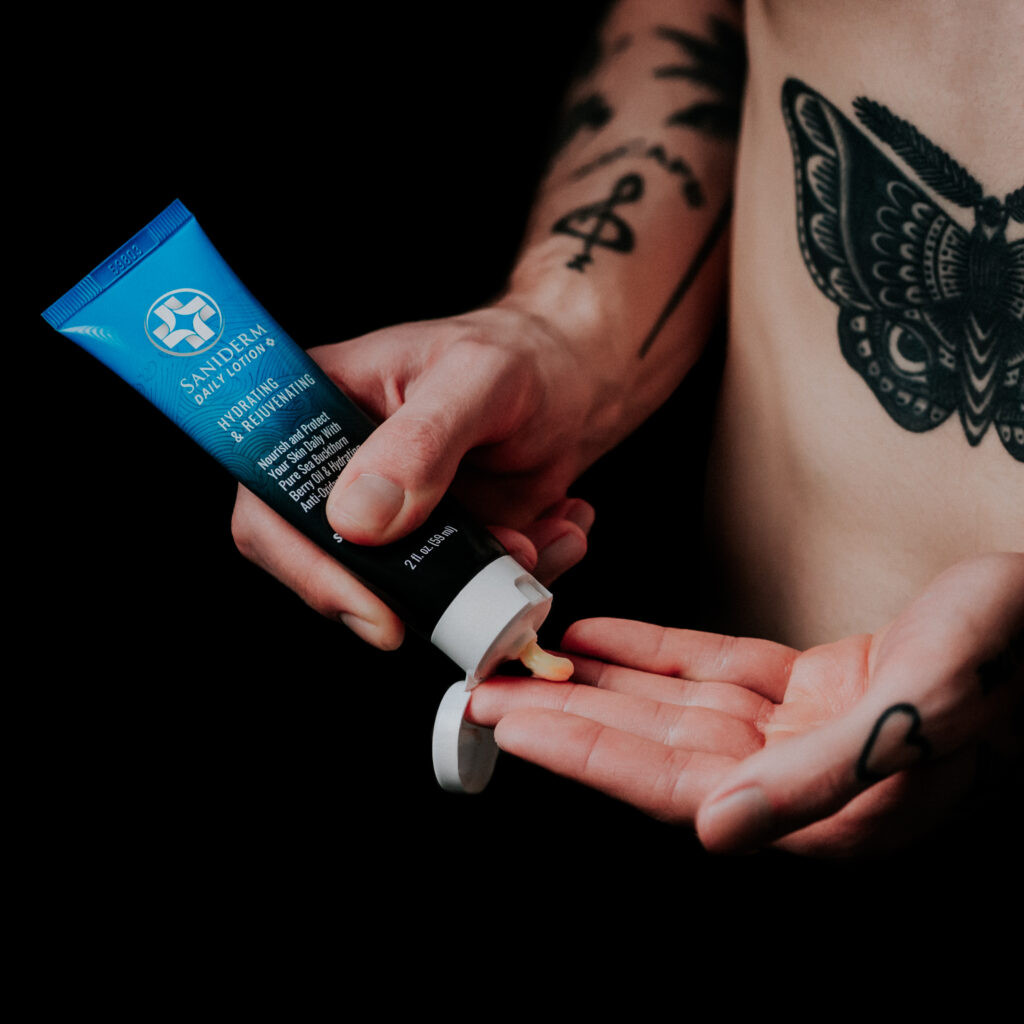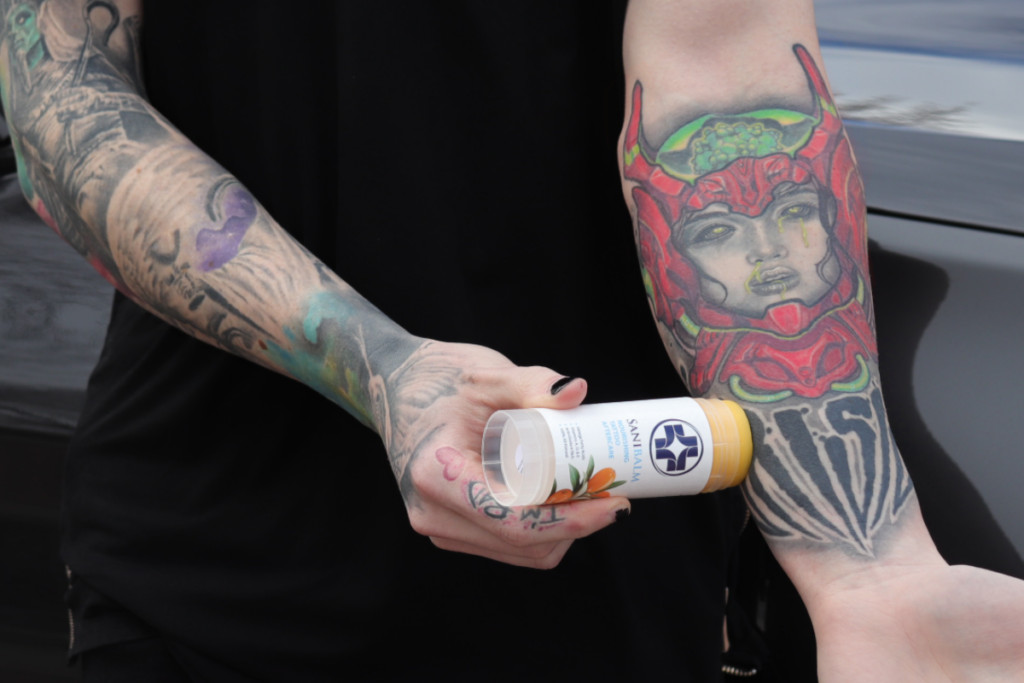How do you know a tattoo is healed? That’s a question many people ask. At tattooat.com, we understand the excitement of getting a new tattoo and the importance of proper aftercare for optimal tattoo aftercare and tattoo design. We’re here to help you understand the tattoo healing stages and ensure your skin art looks great for years to come, using expert tattoo care tips and tattoo healing process information. Let’s dive into the ultimate guide on how to tell when your tattoo is fully healed.
1. What Does A Fully Healed Tattoo Look Like?
A tattoo is fully healed when there are no more scabs, the tattooed skin texture is the same as the surrounding area, and the tattoo is no longer faded. This indicates that the skin has fully recovered and the ink has settled properly.
So, how do you know your tattoo is healed? Knowing when your tattoo has completely healed is essential for long-term tattoo care. Beyond the initial weeks of visible healing, the skin’s deeper layers need time to recover fully. Here’s what to look for:
- No More Scabs: Scabbing is a natural part of the healing process, but once all scabs have fallen off and the skin is smooth, it’s a good sign.
- Consistent Skin Texture: The tattooed area should feel the same as the surrounding skin. There shouldn’t be any raised or rough patches.
- Vibrant Colors: The tattoo’s colors should appear as vibrant and clear as they did when it was freshly inked.
- No Redness or Swelling: Any redness, swelling, or irritation should be completely gone.
- No Shiny Appearance: The skin shouldn’t have a shiny or glossy look, which can indicate that it is still healing.
- No Pain or Discomfort: The area should not be painful, itchy, or tender to the touch.
If all these conditions are met, your tattoo is likely fully healed, and you can return to your regular skincare routine. According to Inked Magazine, proper aftercare during the initial healing phase is crucial for achieving these results.
2. What Is The Tattoo Healing Timeline?
While the surface of your tattoo might look healed in just a few weeks, the complete tattoo healing timeline involves multiple stages and can take several months. Understanding the tattoo healing stages can help you provide the best care.
- Week 1: Inflammation
- What to Expect: Redness, swelling, and soreness are common. The tattoo may ooze blood, plasma, and ink.
- Care: Keep the area clean and follow your tattoo artist’s instructions for bandaging.
- Week 2: Visible Recovery
- What to Expect: The swelling should decrease, and the tattoo might look dull. You’ll likely experience flaking and itching.
- Care: Regularly apply a tattoo ointment or lotion to alleviate discomfort and promote healing.
- Week 3: Invisible Recovery
- What to Expect: Itching should subside, but the skin may still be dry. The tattoo might appear dull.
- Care: Avoid exfoliating or irritating the area. Let the skin slough off naturally.
- Months 2-6: Deep Layer Healing
- What to Expect: The tattoo looks fully healed, but deeper layers are still recovering.
- Care: Continue long-term aftercare, including staying hydrated, protecting the tattoo from the sun, and keeping it clean and moisturized.
The total healing time for a tattoo can vary based on several factors, but it generally takes between 4 to 6 months for a tattoo to fully heal. The size, location, and your body’s healing ability all play a role.
3. What Factors Affect Tattoo Healing?
Various factors can influence how quickly and effectively your tattoo heals. These include your overall health, lifestyle, and how well you follow aftercare instructions.
- Tattoo Size and Location: Smaller tattoos tend to heal faster than larger ones, and areas with more blood flow often heal more quickly.
- Skin Type: Individuals with healthy, well-hydrated skin may experience faster healing times.
- Overall Health: A strong immune system and good overall health can accelerate the healing process.
- Lifestyle: Factors like diet, sleep, and stress levels can impact healing.
- Aftercare: Following your tattoo artist’s aftercare instructions is crucial. Proper cleaning, moisturizing, and protection from the sun can prevent complications and promote faster healing.
4. How Can You Speed Up The Tattoo Healing Process?
While you can’t rush the healing process, certain steps can help speed it up and ensure your tattoo heals properly. Proper tattoo aftercare can improve the overall experience.
- Follow Aftercare Instructions: Adhere to the cleaning and moisturizing schedule recommended by your tattoo artist.
- Stay Hydrated: Drinking plenty of water helps keep your skin hydrated, which is essential for healing.
- Eat a Healthy Diet: Nutrients from a balanced diet support your body’s healing process.
- Get Enough Sleep: Aim for 7-9 hours of quality sleep each night to allow your body to repair itself.
- Avoid Irritants: Stay away from harsh soaps, tight clothing, and excessive sun exposure, all of which can slow healing.
According to research from Portland State University’s Art Department, in July 2023, maintaining a healthy lifestyle significantly impacts tattoo healing.
 A person moisturizing their tattoo.
A person moisturizing their tattoo.
5. What Are The Common Tattoo Healing Problems?
Despite your best efforts, complications can sometimes arise during the tattoo healing process. Being aware of these potential issues can help you address them promptly. Recognizing these issues is vital for effective tattoo aftercare.
- Infection:
- Symptoms: Increased redness, swelling, pain, pus, or fever.
- Action: Seek medical attention immediately.
- Allergic Reaction:
- Symptoms: Rash, itching, hives, or blisters.
- Action: Consult a doctor or dermatologist.
- Scarring:
- Symptoms: Raised or thickened skin in the tattooed area.
- Action: Follow aftercare instructions carefully and consider using scar-reducing products.
- Fading:
- Symptoms: Loss of color or vibrancy in the tattoo.
- Action: Protect the tattoo from sun exposure and maintain proper hydration.
If you notice any of these signs, it’s important to take action promptly to prevent further complications. Always consult with a healthcare professional or your tattoo artist for guidance.
6. What Products Should You Use For Tattoo Aftercare?
Choosing the right products for tattoo aftercare is crucial for promoting healing and preventing complications. Look for gentle, fragrance-free options. High-quality tattoo aftercare products will significantly improve your tattoo’s healing process.
- Cleansers:
- Recommendation: Use a mild, fragrance-free antibacterial soap.
- Why: Gentle cleansers remove bacteria without irritating the skin.
- Moisturizers:
- Recommendation: Choose a fragrance-free, hypoallergenic lotion or ointment.
- Why: Moisturizers keep the skin hydrated and prevent scabbing.
- Sunscreen:
- Recommendation: Apply a broad-spectrum, high-SPF sunscreen once the tattoo is fully healed.
- Why: Sunscreen protects the tattoo from fading and sun damage.
- Balms:
- Recommendation: Use balms with natural ingredients like shea butter or coconut oil.
- Why: Balms provide a protective barrier and promote healing.
Avoid products with harsh chemicals, fragrances, or alcohol, as these can irritate the skin and slow down the healing process.
7. What To Avoid During Tattoo Healing?
Knowing what to avoid during the tattoo healing process is just as important as knowing what to do. Certain activities and substances can interfere with healing. Steering clear of these pitfalls will help ensure your tattoo heals smoothly.
- Sun Exposure:
- Why: UV rays can damage the skin and cause the tattoo to fade.
- Solution: Keep the tattoo covered and avoid prolonged sun exposure.
- Scratching or Picking:
- Why: Scratching or picking can introduce bacteria and lead to infection or scarring.
- Solution: Resist the urge to touch the tattoo and let scabs fall off naturally.
- Tight Clothing:
- Why: Tight clothing can rub against the tattoo and cause irritation.
- Solution: Wear loose, breathable fabrics.
- Soaking:
- Why: Soaking the tattoo in water can increase the risk of infection.
- Solution: Avoid swimming, baths, and hot tubs until the tattoo is fully healed.
- Excessive Sweating:
- Why: Sweat can irritate the skin and increase the risk of infection.
- Solution: Avoid heavy exercise and activities that cause excessive sweating.
Being mindful of these factors can help prevent complications and promote optimal healing.
8. How Does Tattoo Placement Affect Healing?
The location of your tattoo can significantly impact the healing process. Areas with more friction or movement may take longer to heal and require extra care. Different tattoo placements require different aftercare approaches.
- Areas with High Friction:
- Examples: Hands, feet, and inner thighs.
- Considerations: These areas are prone to rubbing, which can cause irritation and slow healing.
- Care: Keep the area clean and moisturized, and avoid wearing tight clothing or shoes.
- Areas with High Movement:
- Examples: Joints like elbows and knees.
- Considerations: Movement can cause the skin to stretch, which can disrupt the healing process.
- Care: Avoid overextending the joint and keep the area moisturized.
- Areas with Sensitive Skin:
- Examples: Neck, face, and inner wrists.
- Considerations: These areas are more prone to irritation and allergic reactions.
- Care: Use gentle, hypoallergenic products and avoid harsh chemicals.
Understanding how tattoo placement affects healing can help you tailor your aftercare routine to the specific needs of your tattoo.
9. What Are The Best Practices For Long-Term Tattoo Care?
Once your tattoo is fully healed, it’s important to maintain a long-term care routine to keep it looking its best. Consistent tattoo maintenance will keep your ink looking fresh and vibrant.
- Sun Protection:
- Why: UV rays can cause tattoos to fade over time.
- Solution: Apply a broad-spectrum sunscreen with a high SPF to protect the tattoo from sun damage.
- Moisturizing:
- Why: Keeping the skin hydrated helps maintain the tattoo’s vibrancy.
- Solution: Moisturize the tattoo regularly with a fragrance-free lotion.
- Healthy Lifestyle:
- Why: A healthy diet and lifestyle can improve skin health and prevent premature fading.
- Solution: Stay hydrated, eat a balanced diet, and avoid smoking and excessive alcohol consumption.
- Regular Check-Ups:
- Why: Monitoring the tattoo for any changes can help identify potential issues early on.
- Solution: Check the tattoo regularly for signs of fading, discoloration, or irritation.
By following these best practices, you can ensure your tattoo remains vibrant and beautiful for years to come.
10. How Can Tattooat.Com Help You?
At tattooat.com, we are dedicated to providing you with the resources and information you need to make informed decisions about your tattoo journey. From inspiration to aftercare, we’re here to support you every step of the way. Explore tattooat.com for a wealth of tattoo resources.
- Design Inspiration: Discover a wide range of tattoo designs and styles to inspire your next piece.
- Artist Directory: Find talented tattoo artists in your area and view their portfolios.
- Aftercare Guides: Access comprehensive guides on tattoo aftercare to ensure proper healing.
- Product Recommendations: Get recommendations for high-quality tattoo aftercare products.
- Community Forum: Connect with other tattoo enthusiasts and share your experiences.
Whether you’re considering your first tattoo or adding to your collection, tattooat.com is your ultimate resource for all things tattoo-related.
 A person helping to heal their tattoo with Sanibalm.
A person helping to heal their tattoo with Sanibalm.
FAQ: How Do You Know A Tattoo Is Healed?
-
How long does it generally take for a tattoo to heal completely?
- A tattoo typically takes 4 to 6 months to heal completely, although the surface may appear healed within a few weeks.
-
What are the main signs that a tattoo is fully healed?
- The main signs include no scabs, consistent skin texture, vibrant colors, no redness or swelling, no shiny appearance, and no pain or discomfort.
-
Can a tattoo heal in two weeks?
- No, a tattoo cannot fully heal in two weeks. While the surface may show signs of healing, the deeper layers of the skin require more time to recover.
-
What should I do if my tattoo is still red and swollen after a month?
- If your tattoo is still red and swollen after a month, consult your tattoo artist or a healthcare professional, as this could indicate an infection or allergic reaction.
-
How important is it to keep a healed tattoo moisturized?
- Keeping a healed tattoo moisturized is very important, as it helps maintain the skin’s hydration and prevents the tattoo from fading.
-
What kind of sunscreen should I use on a healed tattoo?
- Use a broad-spectrum sunscreen with a high SPF to protect the tattoo from UV rays, which can cause fading and damage.
-
Is it normal for a tattoo to itch during the healing process?
- Yes, it is normal for a tattoo to itch during the healing process, but avoid scratching it, as this can lead to infection or scarring.
-
What are some common mistakes to avoid during tattoo aftercare?
- Common mistakes include sun exposure, scratching or picking, wearing tight clothing, soaking the tattoo, and excessive sweating.
-
How does tattoo placement affect the healing process?
- Tattoo placement can significantly affect the healing process, with areas of high friction or movement requiring extra care.
-
When can I start exposing my new tattoo to the sun?
- Avoid exposing your new tattoo to the sun until it is fully healed. Once healed, always apply sunscreen to protect it from UV rays.
Ready to explore the world of tattoos? Visit tattooat.com today for design inspiration, artist recommendations, and expert aftercare advice. Let us help you make your tattoo journey a success! Visit tattooat.com, Address: 1825 SW Broadway, Portland, OR 97201, United States or Phone: +1 (503) 725-3000.
